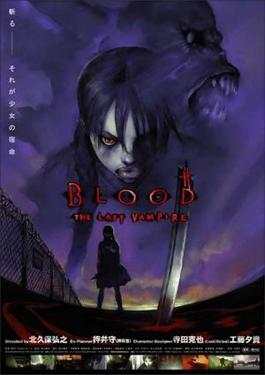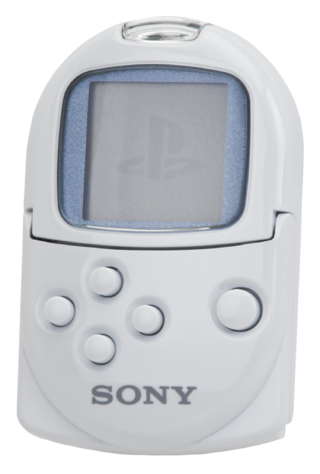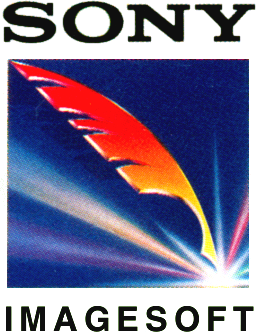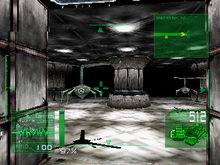
The PlayStation is a home video game console developed and marketed by Sony Computer Entertainment. It was released in Japan on 3 December 1994, in North America on 9 September 1995, in Europe on 29 September 1995, and in Australia on 15 November 1995. As a fifth-generation console, the PlayStation primarily competed with the Nintendo 64 and the Sega Saturn.

Blood: The Last Vampire is a 2000 Japanese animated action horror film directed by Hiroyuki Kitakubo, written by Kenji Kamiyama and produced by Production I.G. The film premiered in theaters in Japan on November 18, 2000.

Sony Interactive Entertainment LLC (SIE) is a multinational video game and digital entertainment company of Sony. Established in 2016, it primarily operates the PlayStation brand of video game consoles and products.

Jumping Flash! is a platform video game developed by Exact and Ultra and published by Sony Computer Entertainment for the PlayStation. It was released on 28 April 1995 in Japan, 29 September 1995 in PAL territories and 2 November 1995 in North America. It was re-released through the PlayStation Network store on PlayStation 3 and PlayStation Portable in 2007, in 2012 on PlayStation Vita and again in 2022 on PlayStation 4 and PlayStation 5.

The PocketStation is a memory card peripheral by Sony Interactive Entertainment for the PlayStation home video game console. It was released in Japan in 1999. The device acted not only as a memory card, but was interactive itself via a small monochrome LCD display and buttons on its case. Many PlayStation games included software that could be downloaded and played on the PocketStation. A release in Europe and North America was planned, but was ultimately canceled. The PocketStation shares similarities with Sega's VMU for the Dreamcast.

Sony Imagesoft Inc. was an American video game publisher that operated from 1989 to 1995 and was located in California. It was established in January 1989 in Los Angeles, California, as a subsidiary of the Japan-based CBS/Sony Group (CSG) and initially named CSG Imagesoft Inc. Their focus at the beginning was on marketing games exclusively for Nintendo consoles.

Tomba! 2: The Evil Swine Return, or simply Tomba! 2, is a platform-adventure game developed by Whoopee Camp and published by Sony Computer Entertainment for the PlayStation. The game was released in Japan in 1999 and in other territories the following year. The game is a sequel to Tomba! and centers on the exploits of the eponymous feral child as he attempts to rescue his friend Tabby from an evil race of anthropomorphic pigs.

Polygon Man was an early marketing character for Sony's PlayStation in North America. Created in 1995 by advertising company Chiat/Day and then-Sony Computer Entertainment America (SCEA) president Steve Race, the character was meant to be an "edgy" spokesperson for the console and target audiences that they feared would be put off by the PlayStation name. Appearing in print advertisements and heavily at the 1995 Electronic Entertainment Expo, global head of the PlayStation brand Ken Kutaragi reacted negatively to the character, feeling it not only misrepresented the PlayStation's abilities but also that funds had been used on an alternative brand. The character was quickly shelved, replaced with the character Sofia from Battle Arena Toshinden while SCEA considered other character options.

Genki Co., Ltd. is a Japanese video game developer. It was founded in October 1990 by Hiroshi Hamagaki and Tomo Kimura, who left Sega to form the company. The company is best known for its racing game titles.

Twisted Metal is a vehicular combat video game developed by Sony Interactive Studios America and SingleTrac and published by Sony Computer Entertainment for the PlayStation. The game was released in North America on November 5, 1995, in Europe on January 13 and in Japan on November 15, 1996. The North American version was re-released for the Sony Greatest Hits line-up on March 3, 1997. It is the first installment in the Twisted Metal series. The game's plot is centered on the titular competition in which various drivers in modified vehicles must destroy the other vehicles in an attempt to be the last one alive. The winner meets the organizer of the competition, a mysterious man named Calypso, who will grant the winner a single wish, regardless of price, size or even reality.

Dark Cloud is an action role-playing video game developed by Level-5 and published by Sony Computer Entertainment for the PlayStation 2. Originally intended as a launch title for the system in March 2000, the game was eventually released in Japan in December 2000, in North America in May 2001, and in Europe in September. A spiritual sequel, Dark Chronicle, was released in Japan in 2002 and worldwide the following year.

God of War III is an action-adventure hack and slash video game developed by Santa Monica Studio and published by Sony Computer Entertainment. First released for the PlayStation 3 on March 16, 2010, it is the fifth installment in the God of War series, the seventh chronologically, and the sequel to 2007's God of War II. Loosely based on Greek mythology, the game is set in ancient Greece with vengeance as its central motif. The player controls the protagonist Kratos, the former God of War, after his betrayal at the hands of Zeus, King of the Olympian gods, whom he learned was his father, Reigniting the Great War, Kratos ascends Mount Olympus until he is abandoned by the Titan Gaia. Guided by Athena's spirit, Kratos battles monsters, gods, and Titans in a search for Pandora, without whom he cannot open Pandora's Box, defeat Zeus, and end the reign of the Olympian gods to have his revenge.
Genki Rockets (元気ロケッツ) is a virtual band created by video game developer Tetsuya Mizuguchi and record producer Kenji Tamai. Rachel Rhodes portrayed the band's frontwoman, a fictional 17-year-old girl named Lumi who was the first human born in outer space on the International Space Station on September 11, 2019.
PlayStation is a video gaming brand that consists of five home video game consoles, two handhelds, a media center, and a smartphone, as well as an online service and multiple magazines. The brand is produced by Sony Interactive Entertainment, a division of Sony.
God of War is an action-adventure game franchise created by David Jaffe at Sony's Santa Monica Studio. It began in 2005 on the PlayStation 2 (PS2) video game console and has become a flagship series for PlayStation, consisting of nine installments across multiple platforms. Based on ancient mythologies, the story follows Kratos, a Spartan warrior and later the Greek God of War, who was tricked into killing his family by his former master, the original Greek God of War Ares. This sets off a series of events that leads to wars with the different mythological pantheons. The Greek-based games see Kratos follow a path of vengeance due to the machinations of the Olympian gods, while the Norse-based games which take place many years after the Greek-based ones and introduce his son Atreus as a secondary protagonist, show an older Kratos on a path of redemption and inadvertently coming into conflict with the Norse gods.

Siren: Blood Curse is a survival horror stealth game developed by Project Siren, a development team of Japan Studio, and published by Sony Computer Entertainment for the PlayStation 3. The third and final installment in the Siren series, Blood Curse was released in July 2008 in Japan and on the PlayStation Store in North America and PAL regions. It was released in October 2008 in Australia and Europe and in December on the PlayStation Store in Japan.

PlayStation Underground is a now-defunct American video game magazine, originally published by Sony Computer Entertainment America. The magazine focused on the PlayStation fanbase, including gaming on the original Sony PlayStation and the PlayStation 2, and was promoted as a "PlayStation fan club". Unlike its paper-based counterpart the Official U.S. PlayStation Magazine, PlayStation Underground came in the form of CD-ROMs which could be played on the PlayStation and PlayStation 2 consoles. Subscribers were also given access to a members-only website. The magazine released its first issue on March 26, 1997 and its final issue in 2001. The magazine released a total of seventeen issues during its active years. The magazine was eventually merged with Official U.S. PlayStation Magazine in 2001 when it was discontinued.
God of War is an action-adventure video game series, the first era of which was loosely based on Greek mythology. Debuting in 2005, the series became a flagship title for the PlayStation brand and the character Kratos is one of its most popular characters. The series consists of nine games across multiple platforms; the first seven make up the Greek era of the series. Five of the Greek era games have been re-released through three separate compilations for the PlayStation 3 (PS3) platform: God of War Collection (2009), God of War: Origins Collection (2011), and God of War Saga (2012). With the exception of God of War III in the God of War Saga, each collection features remastered ports of the games that were not originally released on the PS3. God of War III was later remastered as God of War III Remastered and released on PlayStation 4 (PS4) in July 2015. God of War: Betrayal, God of War: Ascension, God of War (2018), and God of War Ragnarök are the only installments that have not been remastered for a newer platform or included in a collection.

Strike the Blood is a Japanese light novel series by Gakuto Mikumo with illustrations by Manyako, with 22 main volumes published between May 2011 and August 2020. A manga adaptation began serialization in June 2012 in ASCII Media Works's Dengeki Daioh. A 24-episode anime television adaptation by Silver Link and Connect aired between October 2013 and March 2014. An original video animation series titled Strike the Blood II was released in four volumes between November 2016 and May 2017. A third series titled Strike the Blood III was released from December 2018 to September 2019. A fourth series titled Strike the Blood IV was released from April 2020 to June 2021. A fifth and final season titled Strike the Blood Final was released between March 2022 and July 2022.

Epidemic, known as Kileak: The Blood 2: Reason in Madness in Japan, is a first-person shooter video game developed by Genki for the PlayStation console. It is a sequel to Kileak: The DNA Imperative.


















